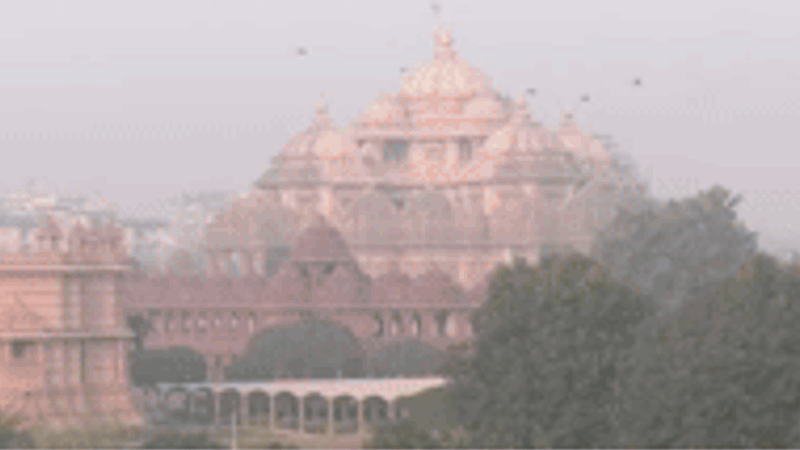Published 23:27 IST, October 30th 2024
Delhi's Air Quality Drops to 'Very Poor' as Diwali Approaches; Authorities Enforce Firecracker Ban
Delhi's air quality worsened to "very poor" before Diwali, with stricter enforcement against firecracker use and increased pollution due to stubble burning and

Delhi's air quality slipped into the "very poor" category on the eve of Diwali , with pollution levels expected to go up on Thursday, even as authorities said strict action will be taken against those violating the firecracker ban.
Current AQI Levels and Predictions
The city's 24-hour average Air Quality Index (AQI) was recorded at 307 at 4 pm, up from 268 on Tuesday, according to the Central Pollution Control Board (CPCB). The Indian Institute of Tropical Meteorology (IITM), Pune, said the air quality in the national capital is likely to be in the "very poor" category (AQI 300 to 400) on Thursday and Friday. The air quality may also reach the severe category on these two days in case of additional emissions from firecrackers and stubble or waste fires.
Impact of Stubble Burning on Pollution
According to the Decision Support System (DSS) for Air Quality Management, if stubble burning occurs at levels similar to the last five years, it could contribute 15-18 per cent to Delhi's pollution on these dates. This is exacerbated by winds from the northwest, which may carry smoke into the city.
Emergency Measures Under the GRAP
Under the Graded Response Action Plan (GRAP), a set of emergency measures to curb air pollution in Delhi-NCR during winter, the air quality is categorised into four stages: Stage I -- "Poor" (AQI 201-300), Stage II -- "Very Poor" (AQI 301-400), Stage III -- "Severe" (AQI 401-450) and Stage IV -- "Severe Plus" (AQI above 450).
Enforcement of Firecracker Ban
Delhi Environment Minister Gopal Rai said 377 teams have been formed to enforce the ban on firecrackers across the national capital. He said authorities are in touch with resident welfare associations (RWAs), market associations, and social organisations to spread awareness. A senior Delhi Police officer said all deputy commissioners of police (DCPs) have been asked to form dedicated teams to ensure that firecrackers are not burst in their respective districts.
Legal Actions Against Violations
"Legal action will be taken against those found bursting crackers. They may also be booked under the relevant sections of the BNS (Bharatiya Nyaya Sanhita) for violating government orders," he said.
Weather Conditions and Wind Patterns
Mahesh Palawat of Skymet Weather Services told PTI that on Diwali, pollution levels are likely to rise as winds have shifted from south-southeast to northwesterly, which may carry smoke from stubble burning into the city. "If firecrackers are also burst, the altered wind direction could further trap pollutants, worsening the air quality," he said.
Public Appeals from Officials
Meanwhile, former Delhi chief minister and AAP convenor Arvind Kejriwal defended the ban on firecrackers, saying it is necessary to protect people from pollution and there is no "Hindu-Muslim" angle to it. Even the Supreme Court and the high court have said people should refrain from bursting crackers in view of the pollution and light earthen lamps instead as Diwali is a festival of lights, Kejriwal said at a press conference.
Monitoring Station Data and AQI Levels
Of the 40 air-quality monitoring stations in the capital, data from 38 was shared by the CPCB on Wednesday. The AQI in Anand Vihar and Mundka remained "severe", with AQI levels above 400. The air quality in Alipur, Ashok Vihar, Bawana, Burari, Wazirpur, Jahangirpuri, Narela, Nehru Nagar, North Campus and Vivek Vihar was recorded in the "very poor" category. In Delhi's neighbouring areas like Ghaziabad, Gurugram, Greater Noida and Noida, the air quality remained "poor". In contrast, Faridabad's air quality was "moderate" with a reading of 181, according to the CPCB.
Comparative Air Quality from Previous Years
Last year, Diwali was celebrated on November 12 and Delhi recorded its best air quality on Diwali day in eight years, with the average AQI at 218.
Primary Pollutants and Health Risks
PM10 was the prominent pollutant in Delhi on Wednesday. PM10 is particulate matter that is 10 micrometre or less in diameter. These tiny solid or liquid particles suspended in the air can be inhaled deep into the lungs, potentially leading to issues such as asthma, bronchitis, and other respiratory diseases. The PM2.5 level was recorded at 116 micrograms per cubic metre at 4 pm. PM2.5 is a fine particulate matter capable of penetrating deep into the respiratory system and triggering health problems.
Vehicular Emissions and Other Pollution Sources
Vehicular emission was the biggest contributor to Delhi's pollution on Wednesday, accounting for approximately 16.2 per cent, which was 15.7 per cent on Tuesday, according to the Centre's Decision Support System for Air Quality Management. It is predicted that vehicular emissions will remain the top contributor to Delhi's pollution over the next two days, with an estimated share of approximately 13 per cent.
Apart from transport, other contributors to Delhi's pollution include farm fires. The Delhi government has requested the neighbouring states of Punjab, Haryana, and Uttar Pradesh to minimise these as much as possible. Data shows that on Wednesday, a total of 110 farm fires were recorded in Punjab, three in Haryana, and 47 in Uttar Pradesh. Between September 15 and October 30, a total of 2,466, 742, and 1,039 farm fires were recorded in Punjab, Haryana, and Uttar Pradesh respectively.
(Except the headline, this story is not edited by Republic and is published from a syndicated feed)
Updated 23:27 IST, October 30th 2024




